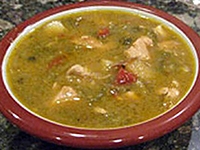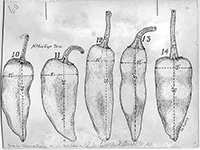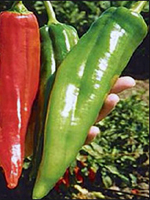 |
Classic New Mexico Green Chili Sauce |
A completely traditional Mexican Chile Verde is a green chile stew, more like a sauce, without any tomatoes at all and often with no meat either. However, in practice, some tomatoes are sometimes included to impair a smooth flavor to the dish or to tone down the heat, but not too much or the sauce turns red. It is usually used as a topping for other dishes, rather than a meal by itself.
The proper choice of chile peppers is essential to this dish. The chiles are the main ingredients, as is obvious from the list below. There is no meat. Do not use just any green chile: anaheim or poblanos are too mild; jalapenos are too hot plus do not have the right flavor. Finding New Mexico chile pods is essential. This may be difficult to accomplish if you are, say, in Thailand, but there are ways to mail order them fresh or dried, or as seeds, through many online vendors, even Amazon or Ebay! We get ours from Los Chileros de Nuevo Mexico.
Chile peppers are a big deal in New Mexico. Chile is the most important agricultural crop in the state today. All New Mexican chile peppers (Chile Nuevo Mexicano) are from the same species (Capsicum annuum, just like most peppers in Mexico. But what is not generally known is that all New Mexican chile peppers are the same cultivar, and descend genetically from the "The New Mexico No. 9" variety cultivated in 1913 by Dr. Fabian Garcia. For the avoidance of confusion, there are other chile peppers being grown in New Mexico today (i.e. piquin, jalapeño or habanero), but they are not the same as the "New Mexican chile pepper" (Chile Nuevo Mexicano).
 Garcia's "New Mexico No. 9". |
Read our essay on the history of Mexican food for more details.
All New Mexican-type chiles grown today gained their genetic base from cultivars
developed at New Mexico State University. The New Mexico No. 9 was the most important one,
but other cultivars based on the New Mexican pod followed.
What can be bought most frequently today are:
- Sandia (medium-hot, 1,500–2,000)
- New Mexico 6-4 (mild, 300–500)
- NuMex Big Jim (medium-hot, 500–2,000)
- NuMex Joe E. Parker (mild, 800–900)
- NuMex Garnet in 2004 (very mild, 150–160)
 |  |
| Numex Big Jim. | Numex Joe E. Parker. |
Ingredients:
- 2 lbs fresh New Mexico green chile, roasted, peeled and chopped
- 1 tbsp New Mexico green chile powder
- 2 tbsp olive oil (butter may be substituted)
- 2 cloves of fresh garlic, finely minced
- 1 large white onion, chopped
- 1-2 cans of chicken stock
- 1/2 can of diced tomatoes (completely optional as this is not traditional)
- 1/2 tsp salt
- 1 tsp sugar (optional)
- Pinch of ground cumin (optional)
Preparation:
- Heat 1 tbsp of the oil in a large saucepan or iron skillet. Add the onions and sauté until the onions start to become translucent. Add the garlic and continue to sauté until the onions are fully translucent.
- Increase heat and add the fresh chile and sauté (the mixture should start bubbling). Add the green chile powder and 1 can of the chicken stock. Add more as needed. The sauce should not be too runny or too thick. Add the cumin, careful not to use too much as it will ruin the sauce. Add the sugar (optional), stir and simmer for a few minutes. Taste and adjust seasonings. If too spicy, stir in some of the tomatoes to cool it down.
- Continue to simmer until the sauce reaches desired consistency. Add some more green chile powder to make it thicker. The finished stew should look like in the photograph.
- Serve with buttered tortillas or cornbread.
back to Radim and Lisa's Well-Travelled Cookbook | email us
Last updated: June 1, 2014